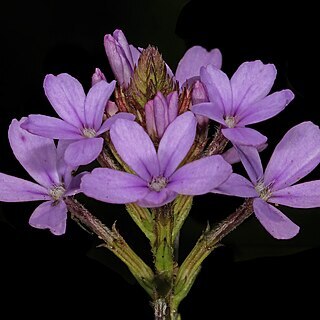An erect or suberect herb, hispidulous or nearly glabrous, somewhat scabrid, 1/2-2 ft. high, simple or branched, rigid, apparently annual, turning black in drying; stems firm, rather slender, obtusely quadrangular or near the base subterete, furrowed above, somewhat woody at the base, leafy; branches ascending or suberect; leaves opposite or the upper alternate, obovate, oblanceolate or sublinear, rounded or obtuse, attenuate or somewhat narrowed at the base, sessile or subpetiolate, entire, firmly herbaceous, hispidulous-scabrid, 1/2-2 1/2 in. long, 1/24-5/8 in. broad, the lower the broader and 3-nerved; flowers spicate, numerous, deep purple or pale lilac, about 3/8 in. long; spikes elongating, narrow, dense above, at length lax and interrupted below, not markedly tetragonal, 1-7 in. long; pedicels very short; bract ovate, concave, acute, clasping the calyx, ciliate, otherwise glabrous, in. long; bracteoles smaller, acute or subulate 1/10-1/6 in. long; calyx oblong, 1/5-1/3 in. long in flower, 1/4 in. long in fruit; tube 1/8-1/5 in. long, glabrous or nearly so, 8-or 10-ribbed; lobes 4 or 5, ovate or lanceolate or subulate, acute, ciliate, otherwise glabrous, unequal, 1/24-1/12 in. long; corolla-tube slender, about 1/3-3/8 in. long, finely and sparingly pilose outside; limb at length spreading, quincuncial in bud; lobes oval or obovate, glabrous on both faces, 1/12-1/5 in. long, rounded at the apex, emarginate, minutely undulate on the margin; stamens and style included within the corolla-tube; capsule oval-oblong, about 1/4 in. long; seeds irregularly oval or oblong, numerous, nerved, somewhat reticulate.
More
Annual or perennial herb, parasite, 0.06-0.60 m high; stem terete, erect or Sub-Erect, puberulent. Leaves opposite, lower obovate, middle oblong, upper linear, hispid. Inflorescence a long, terminal spike; flowers pale blue or deep lilac. Bracts ovate, concave, ciliate. Calyx oblong, 5-8 mm long ± glabrous, 8-or 10-ribbed; lobes lanceolate or ovate, ciliate, apex acute. Corolla with slender tube, externally pilose; lobes oval or bovate, glabrous. Stamens and style included in corolla tube. Flowering time Nov.-July. Fruit included in calyx when mature.
Annual or perennial hemiparasitic herb, up to 0.3 m high. Stems erect, slender, much branched from base; leafy; drying black. Leaves sessile; blade narrowly ovate-obovate or sublinear, 12-35 mm long, hispidulous-scabrid. Flowers: many in a spike; corolla with tube softly hairy, purple or blue; Nov.-Jan.
Slender, semiparasitic herb, up to 300 mm tall, much-branched from base, drying black. Leaves opposite, obovate oblanceolate or sublinear, hispidulous-scabrid. Flowers spicate, numerous, purple or blue.
Hemiparasitic perennial to 60 cm. Leaves mostly basal, shortly scabrid. Flowers in spikes, blue-purple, corolla hairy.

